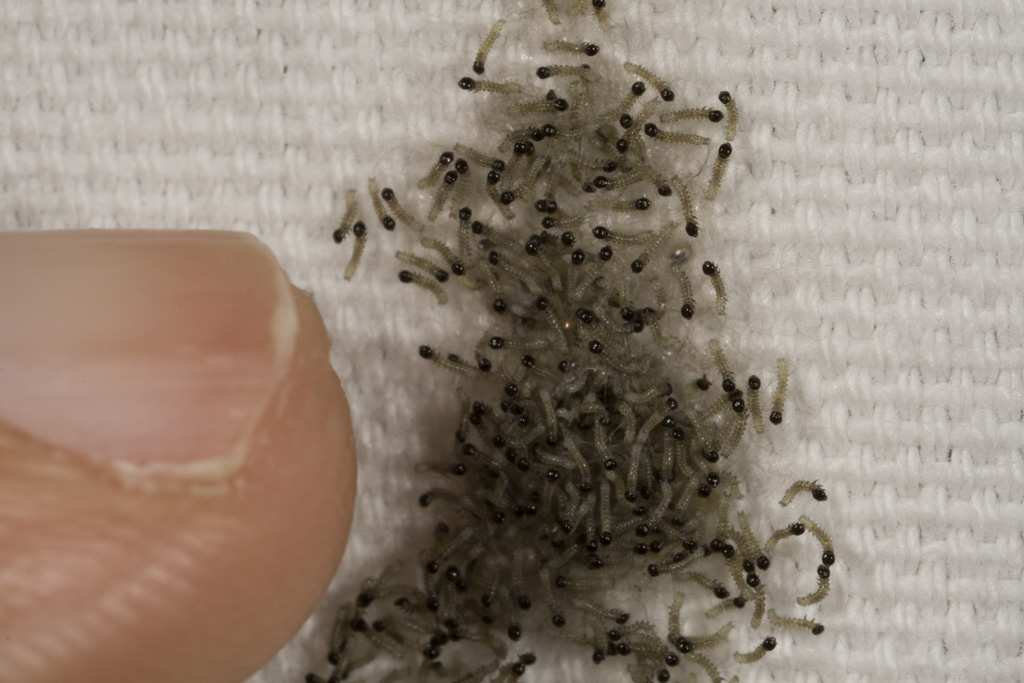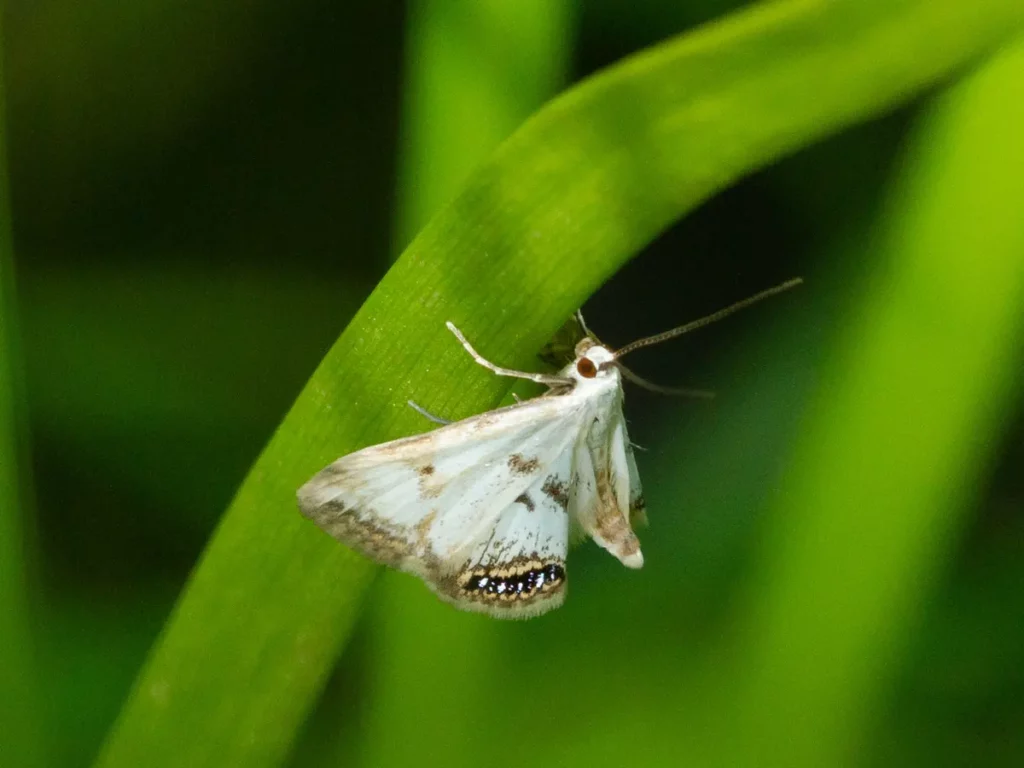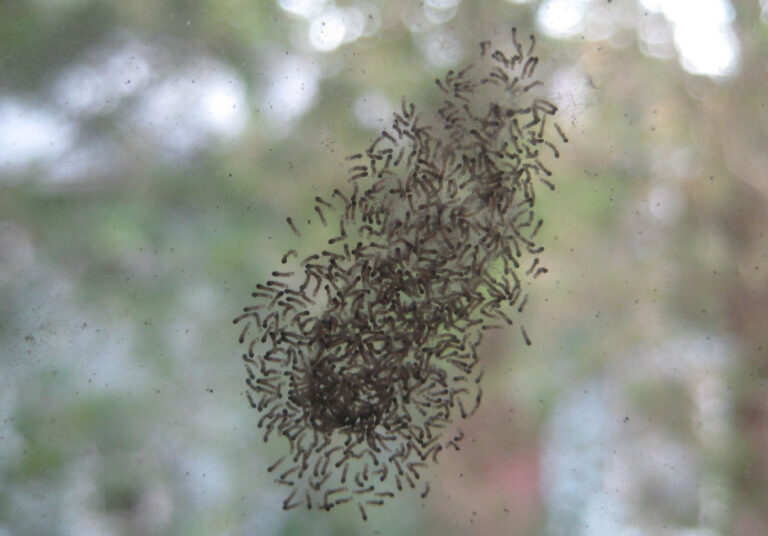Baby moths, also known as caterpillars or moth larvae, have distinct characteristics that set them apart from adult moths. They are small, segmented, and lack antennae. Caterpillars come in various colors, often serving as camouflage.
Moreover, they have a head with simple eyes, chewing mouthparts, and multiple pairs of prolegs for movement. Some caterpillars have defensive features like spines or hairs. They go through multiple growth stages, shedding their exoskeletons, until they reach their final instar.
Eventually, they pupate to undergo metamorphosis into adult moths, experiencing significant changes during this transformation. The specific appearance of caterpillars varies among moth species.
How do moths go through their life cycle?

Moths, like butterflies, undergo a complete metamorphosis, consisting of four distinct stages: egg, larva (caterpillar), pupa (chrysalis), and adult.
Furthermore, this life cycle is a key characteristic of insects in the order Lepidoptera, which includes both moths and butterflies.
Each stage serves a specific purpose in the moth’s development and contributes to its survival and reproduction.
Explanation of the Stages in a Moth’s Life:
- Egg Stage: This is the initial stage where the adult moth lays eggs, typically on or near the host plant.
- Larval Stage: After hatching from the egg, the larva (commonly known as a caterpillar) emerges. It is the growth and feeding stage of the moth’s life.
- Pupal Stage: Following the larval stage, the caterpillar enters the pupal stage. During this time, the moth undergoes a remarkable transformation inside a protective casing.
- Adult Stage: The final stage is the emergence of the fully developed adult moth from the pupal case. This is the reproductive stage, where moths mate and lay eggs to start the cycle anew.
What are moth eggs like?
Moth eggs come in various shapes, sizes, and colors, depending on the moth species. They can be round, oval, or cylindrical.
Most moth eggs have a protective outer shell that helps shield the developing embryo from external threats, such as predators and environmental conditions.
In addition, the coloration of moth eggs can range from translucent to solid colors like white, green, or brown.
Where Moths Typically Lay Their Egg
Moths are highly diverse in their choice of egg-laying sites. Some moths lay their eggs on the leaves of host plants, as the emerging caterpillars will feed on these leaves.
Others may lay eggs on structures or objects that mimic the appearance of their host plants, providing camouflage for the eggs.
Some moth species are highly selective about where they lay their eggs, preferring specific plant species or parts of plants. Moths may also choose locations where their eggs are less likely to be detected by predators.
Importance of the Egg Stage in Moth Development
The egg stage is critical in the moth’s life cycle, as it marks the beginning of a new generation. The survival and success of the species depend on the adaptability and suitability of the chosen egg-laying sites.
Environmental factors, such as temperature and humidity, can influence egg development and hatching success.
Understanding the egg stage is crucial for conservation efforts, as it helps identify vulnerable species and protect their habitat.
How do baby moths (caterpillars) differ from adult moths?
Baby moths, in their larval stage, are commonly known as caterpillars. Caterpillars vary greatly in appearance, depending on the moth species, but they generally have long, cylindrical bodies covered in soft, often bristly hairs.
These hairs can serve various purposes, such as protection from predators or providing sensory functions. Caterpillars have a distinct head with powerful jaws for chewing plant material.
Differences Between Baby Moths and Adult Moths:
| Characteristic | Caterpillars | Adult Moths |
| Appearance | Lack wings and scales | Possess wings and characteristic scales |
| Behavior | Herbivorous, focused on feeding and growth | Often focus on reproduction and nectar-feeding |
| Stage Specialization | Specialized for growth and survival | Specialized for reproduction |
Various Species of Baby Moths and Their Unique Characteristics
Caterpillars come in an astonishing variety of shapes, sizes, and colors, with specific adaptations to their environments.
Some caterpillars are cryptically colored to blend in with their host plants or mimic objects in their surroundings, while others have vibrant warning colors to deter predators.
Certain species exhibit fascinating behaviors, such as silk-spinning to create protective shelters or webbing for group living.
Examples of unique caterpillar features include stinging hairs in some species that can deliver venomous bites.
Behavior and Habits of Baby Moths
The behavior of caterpillars varies widely, but most share common traits, such as a strong feeding drive.
They are often found munching on leaves and can consume a significant amount of plant material relative to their size.
Caterpillars have diverse strategies to avoid predators, including hiding during the day, producing defensive chemicals, or using mimicry.
As they grow and prepare for the next stage, caterpillars may seek out a suitable location to pupate, often creating silk threads to anchor themselves.
How do baby moths transform into pupae?
The pupal stage is a transformative phase in a moth’s life cycle where the caterpillar undergoes metamorphosis into an adult. During pupation, the caterpillar ceases feeding, its body undergoes significant internal changes, and it becomes enclosed in a protective casing called a chrysalis or pupa.
Furthermore, the pupal stage can last from days to months, depending on factors like temperature and species.
How Baby Moths Transform into Pupae
Before pupation, the caterpillar typically searches for a sheltered and secure location to pupate, such as under a leaf or within a cocoon.
Inside the pupa, the caterpillar’s body undergoes a radical transformation. It reorganizes its tissues, forming the structures of an adult moth, including wings, antennae, and reproductive organs.
Some moth species pupate within a cocoon made of silk, while others pupate naked, without a protective casing.
Protective Features of Moth Pupae
The chrysalis or pupa serves as protection against environmental hazards and predators.
Its color and shape often blend with the surroundings, providing camouflage.
Some pupae have hard, durable shells, while others may be softer but equipped with mechanisms to deter predators, such as spines or spiky appendages.
What distinguishes the appearance of adult moths?
Adult moths are characterized by their scaled wings, which are often covered in intricate patterns. Moth species vary greatly in size, color, and wing shape, with some being brilliantly colored while others are more muted.
Furthermore, the antennae of adult moths are feathery or filamentous, which they use for sensing pheromones and environmental cues. The primary function of adult moths is reproduction, and their appearance often reflects adaptations related to courtship and mating.
Importance of Understanding the Development Process
Understanding the complete life cycle of moths, from egg to adult, is essential for conservation and pest management efforts.
It allows scientists and researchers to identify vulnerable stages and target conservation strategies effectively.
Understanding the development process also aids in predicting population dynamics and potential outbreaks of moth species, whether they are beneficial or harmful to ecosystems and agriculture.
Connection Between Baby Moths and Adult Moths
The metamorphic transformation from baby moth (caterpillar or larva) to adult moth is a remarkable process.
It involves the complete reorganization of the insect’s body, including the development of functional wings for flight and reproductive organs.
Adult moths are responsible for mating and laying eggs, initiating a new generation of baby moths, thus continuing the life cycle.
How do baby moths adapt to their environments?

Baby moths, especially in their larval stage, often adapt to their environments by closely resembling their host plants or other elements in their surroundings. This adaptation helps them hide from predators and blend in seamlessly with their habitat.
In addition, some caterpillars have evolved behaviors that include feeding at night or hiding in sheltered locations during the day to further avoid detection.
Camouflage Strategies Used by Baby Moths
Camouflage in baby moths can take various forms, including color mimicry and structural adaptations.
Some caterpillars mimic the appearance of leaves, twigs, or even bird droppings to deter predators.
Structural adaptations may include appendages or body shapes that resemble thorns or spines, making the caterpillar unpalatable or discouraging attacks.
How Baby Moths Avoid Predators:
Baby moths employ numerous defensive tactics to avoid predators, such as regurgitating noxious substances or secreting irritants.
Some caterpillars spin silk threads to lower themselves to safety when threatened. Group living, where several caterpillars cluster together, can enhance protection through collective defense.
What are common threats to baby moths?
Common predators of baby moths include birds, spiders, parasitoid wasps, and other insects.
Some predators have developed specific adaptations for feeding on caterpillars, such as long beaks for extracting caterpillars from their hiding places.
Natural Threats to Baby Moths
Environmental factors like weather, pathogens, and competition for resources can pose significant threats to baby moths.
Parasitoid wasps lay their eggs inside caterpillars, and their larvae consume the caterpillar from the inside, ultimately killing it.
Human Impact on Baby Moth Populations
Habitat destruction, pollution, and climate change can affect the availability of host plants and disrupt the life cycle of baby moths.
Pesticides used in agriculture can harm both baby moths and their natural predators, disrupting the balance of ecosystems.
FAQ’s
What do newborn moths eat?
Newborn moths, in their larval stage, typically eat plant material, such as leaves or fabric if they are clothes moths.
How can you tell if it’s a moth?
You can usually identify a moth by its characteristic scaled wings, feathery or filamentous antennae, and behavior, such as nocturnal activity.
Do moths lay eggs in your room?
Yes, moths can lay eggs in your room, especially if they find suitable materials like clothing, fabric, or stored food.
What kills moths?
Moths can be killed using various methods, including pesticide sprays, moth traps, or natural predators like spiders.
What kills clothes moths?
Clothes moths can be eliminated through methods such as washing infested items, freezing, or using moth repellents and traps.
Can you touch a moth?
Yes, you can touch a moth gently, but it’s best to handle them with care to avoid damaging their delicate wings.
Final Words
In conclusion, this exploration of the life cycle of moths has provided us with a comprehensive understanding of these remarkable insects and their various developmental stages.
From the delicate beauty of moth eggs to the astonishing transformations that occur during pupation, each phase of their life cycle plays a crucial role in their survival and reproduction.
Furthermore, we have uncovered the intriguing strategies employed by baby moths, including camouflage and adaptations, to navigate their environments and avoid predators.
Yet, despite these adaptive mechanisms, baby moths face numerous challenges, including natural predators and human-induced threats.

